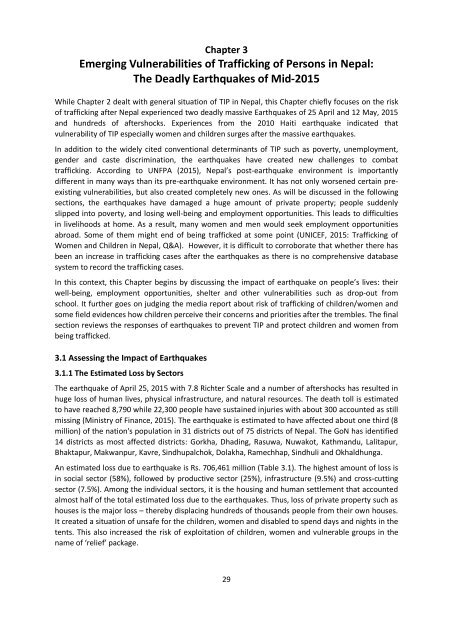TRAFFICKING IN PERSONS
1Spfyta
1Spfyta
You also want an ePaper? Increase the reach of your titles
YUMPU automatically turns print PDFs into web optimized ePapers that Google loves.
Table 3.2 Population estimated affected by the earthquakes, Nepal<br />
Number<br />
Total population 5,700,000<br />
Total women’s population (50.5%) 2,710,239<br />
Female headed households (26.5%) 326,943<br />
Women with disabilities 39,987<br />
Elderly women (65 + years 6% of the total female population) 163,043<br />
Girls under 14 years of age (28% of the total female population) 764,226<br />
Illiterate women (29% of the total female population) 794,529<br />
Dalit population (16.3%) 929,000<br />
Number of children out of school 1,399,000<br />
Pregnant and lactating women 126,000<br />
Number of women at risk of gender-based violence 40,000<br />
Source: Gender Equality Bulletin No. 1.<br />
3.1.3 Increase in Number and Proportion of Poor<br />
According to the World Bank estimate (2015)5, the proportion of poor in Nepal will increase by 2<br />
percent (on the assumption of low impact), by 2.8 percent (on the assumption of medium impact) by<br />
3.7 percent (on the assumption of high impact) into poverty in 2015/16. The proportions and<br />
number of poor would substantially increase in mountains and central hills of Nepal. With the<br />
assumption of medium-impact of the earthquake on the Nepalese economy, the proportion of poor<br />
in mountains would increase to 43.8 percent from 35.9 percent; and in central hills, it would<br />
increase from 25.8 percent to 41.2 percent. The absolute number of poor at the national level, on<br />
the assumption of earthquake impact of low, medium and high scenarios, will be 561,000; 786,000<br />
and 1038,000, respectively. Almost half number of poor of Nepal would be in central hills. Thus,<br />
central hills and mountains would be the pocket of poverty-hit areas coupled by the emotional and<br />
psychological distress. This is one of the crucial vulnerability situations of all persons including<br />
children, young, adult, elderly, men and women.<br />
Table 3.3 Poverty impact earthquake of April 25, 2015 and aftershocks under three scenarios<br />
% of poor Low impact Medium-impact High impact<br />
(Baseline<br />
no<br />
earthquake<br />
scenario<br />
2015)<br />
% poor Number<br />
of poor<br />
(in ‘000)<br />
% poor Number of<br />
poor (in<br />
‘000)<br />
% poor Number of<br />
poor (in<br />
‘000)<br />
National 21.2 23.2 561 24.0 786 24.9 1038<br />
Mountains 35.9 41.1 102 43.8 152 45.1 180<br />
Urban<br />
Kathmandu 9.4 12.1 43 13.0 56 14.6 82<br />
Other hills 7.3 7.8 6 7.8 6 7.8 6<br />
Rural<br />
Eastern<br />
hills<br />
13.0 13.7 13 14.1 19 14.2 22<br />
Central<br />
hills<br />
25.8 36.6 280 41.2 395 45.1 500<br />
Western 21.8 24.3 66 25.8 106 27.1 141<br />
hills<br />
Source: NPC, 2015a.<br />
5 The World Bank (cited in NPC, 2015) carried out the impact of earthquakes of April 25 and aftershocks on poverty level in<br />
Nepal under three different scenarios: low, medium and high impact. Four indicators were taken into account: i) % loss<br />
of housing and durable assets loss (50%, 70% and 100% for low, medium and high, respectively); ii) % loss in annual<br />
income loss (35%, 45% and 50% for low, medium and high respectively); iii) % of growth rate in 2015/16 (4.5%, 4.5% and<br />
4% in low, medium and high, respectively) and iv) % increase in foreign remittance (15%, 5% and 0% for low, medium<br />
and high projection, respectively).<br />
31


